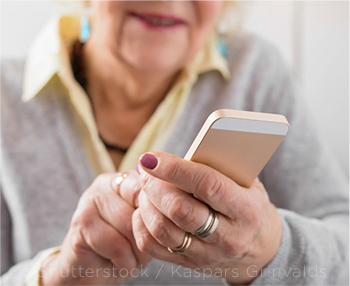Download PDF
During the pandemic lockdown, ophthalmologists at the Singapore National Eye Centre (SNEC) found that some patients with retinal diseases could successfully use a smartphone-based app to monitor their eyes for signs of progression.1
 |
FOLLOW-UP? Home testing flagged a subset of patients who needed in-person exams.
|
Timely detection. The 732 participants in the SNEC study tested themselves at home for signs of metamorphopsia with the FDA-approved Alleye smartphone app (Oculocare Medical). The app requires the patient to perform a series of dot-alignment hyperacuity tasks on the phone screen.2
Researchers viewed test results on a dedicated monitoring portal to identify a loss in hyperacuity (considered a “trigger event”), which may precede symptomatic visual deterioration, so the patient could be brought into the clinic for follow-up. The patients had diagnoses of diabetic macular edema, wet or dry age-related macular degeneration, diabetic retinopathy, or retinal vein occlusion.
During Singapore’s lockdown in early 2020, when routine appointments were postponed, the app showed trigger events in 33 patients, seven of whom were called in for exams after a telephone consultation. Of these, five subsequently proved to have clinically verified disease progression. When the remaining 26 patients were examined at rescheduled appointments, 20 were found to have no disease progression.
“We believe that such self-monitoring mobile apps, if correctly paired with an education effort [and robust follow-up], represent a novel model of care that should be adopted,” said study leader Kelvin Y. Chong Teo, MBBS, MMed (Ophth), at the Singapore Eye Research Institute and the Duke-NUS academic clinical program. Such a model of care could help limit the number of “arbitrary monitoring visits” that are often of low yield, he noted.
Imperfect rollout. Because of the unanticipated COVID-19 lockdown, patients who agreed to enroll in this self-monitoring initiative did not have the recommended face-to-face instruction on how to use the app. This may be why only 43% of the participants complied with the request that they test their affected eyes twice a week, the researchers said. When the 33 participants were questioned about their trigger events, 15 had not tested their eyes as often as prescribed, six had been testing the wrong eye, and five reported having trouble using the test.
Looking ahead. Despite these difficulties, Dr. Teo said, the study outcomes hint at how a properly implemented self-monitoring system might benefit certain patients.
“What we found, unsurprisingly, was that younger patients or those who had family support were more likely to sign up and be adherent to the program,” he said. Other patients who participated actively were those who had poor vision in one eye. “We postulate that they were more fastidious in monitoring their vision in their good eye and hence more adherent,” he noted.
Dr. Teo said the SNEC continues to use self-monitoring initiatives to augment care for patients with retinal diseases. “Such initiatives should not shortchange interactions between physician and patient. Instead, they can serve to allow for a more tailored level of care, where patients are able to access care when they require it.”
—Linda Roach
___________________________
1 Chong Teo KY. Ophthalmol Retina. Published online Feb. 18, 2021.
2 Schmid MK et al. Eye (Lond). 2019;33(10):1584-1589.
___________________________
Relevant financial disclosures: Dr. Teo—Bayer: L; Novartis: L; Topcon: L.
For full disclosures and the disclosure key, see below.
Full Financial Disclosures
Dr. Korenfeld Encore Vision: S; EyeGate: C; EyePoint: C; Novartis: C,S; Orasis: C.
Dr. Shekhawat NEI: S.
Dr. Teo Bayer: L; Novartis: L; Topcon: L.
Dr. Woreta None.
Dr. WuDunn Allergan: S.
Disclosure Category
|
Code
|
Description
|
| Consultant/Advisor |
C |
Consultant fee, paid advisory boards, or fees for attending a meeting. |
| Employee |
E |
Employed by a commercial company. |
| Speakers bureau |
L |
Lecture fees or honoraria, travel fees or reimbursements when speaking at the invitation of a commercial company. |
| Equity owner |
O |
Equity ownership/stock options in publicly or privately traded firms, excluding mutual funds. |
| Patents/Royalty |
P |
Patents and/or royalties for intellectual property. |
| Grant support |
S |
Grant support or other financial support to the investigator from all sources, including research support from government agencies (e.g., NIH), foundations, device manufacturers, and/or pharmaceutical companies. |
|
More from this month’s News in Review